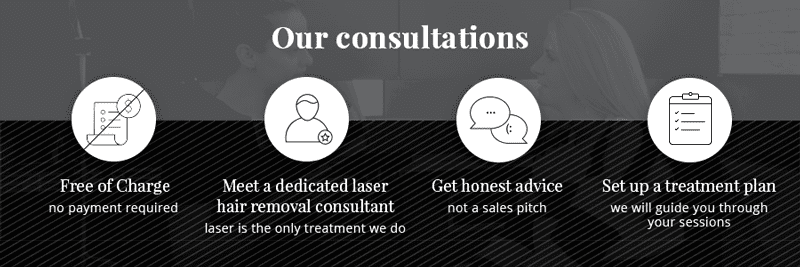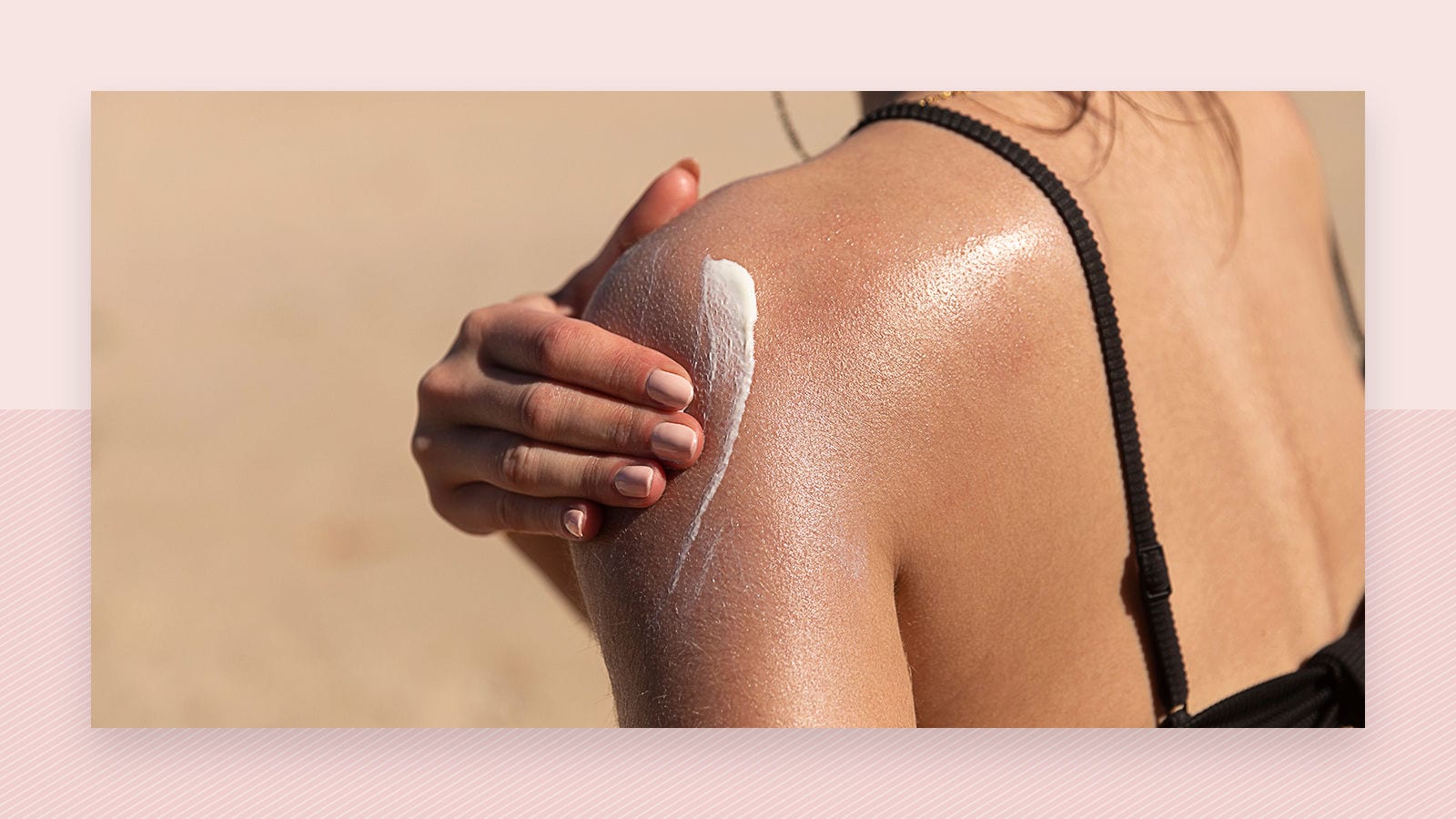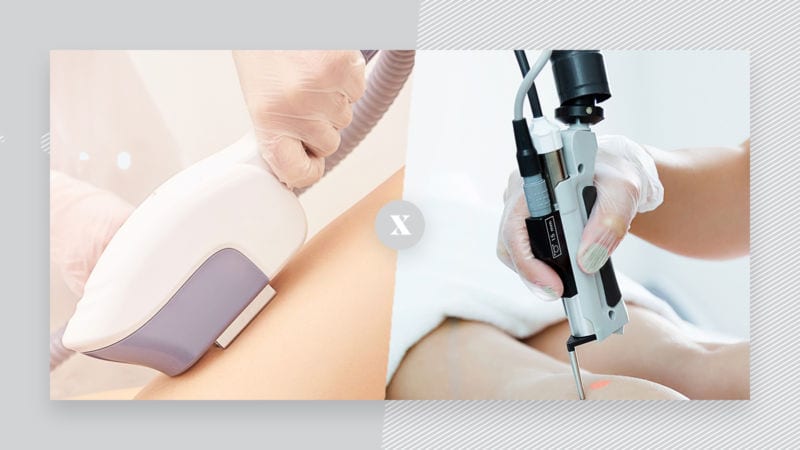Do you need to use SPF every day if you are having laser hair removal?
Yes, you do need to use SPF every day if you are having laser hair removal on an area that is constantly exposed. The most common area that tends to be exposed is the face and neck. UVA and UVB rays penetrate cloud cover and impact on our skin daily. If your treatment areas are regularly exposed a broad spectrum sunscreen of SPF 50, PA++++ is recommended.

For facial and exposed areas you need to wear SPF throughout the year if you are having laser hair removal. Any changes in skin colour may not be as noticeable as they are in the summer months but skin may become sensitive over time if it is not protected.
Why is laser dangerous on tanned skin?
Performing a laser treatment on tanned skin can result in pigmentation. It is essential that skin is allowed a rest period after sun exposure before commencing with treatment. Allowing this time will result in a tan fading.
When skin is tanned melanocytes are activated and melanin is produced in order to protect the skin. This is how a tan develops. A rest period of approx 6-8 weeks after sun exposure will cause these melanocytes to stop producing active melanin.
Laser hair removal works by delivering pulses of energy into the skin. This energy is rapidly absorbed by melanin, this is the reason why laser will only work on dark hairs. If a tan is present too much energy will be absorbed by the skin during treatment. If this happens it will result in pigmentation which may take long periods to fade.
For darker skin types energy from the laser is delivered in a different way so the skin will be safe. Naturally darker skin types are treated with an Nd:Yag laser. Even when using this laser a wait time of approximately 6 weeks is recommended after sun exposure.
What level of SPF protection do you need to use every day when having laser hair removal?
A minimum of Broad Spectrum SPF 50 PA++++ is needed when having laser hair removal. By investing in a high quality SPF you will get the most out of your course of laser hair removal. At the start of a course a setting will be selected based on the skin and hair type. After each session if the skin remains stable these settings will be increased accordingly. Over the first few sessions settings will be conservative in order to establish what the skin can tolerate. Once the hair starts to thin out it is essential that settings be increased in order to target them. However, if after session 4 the skin colour changes due to sun exposure settings will have to be reduced making treatment less effective.
Using a high performing SPF of no less than 50 and keeping sun exposure to a minimum will reduce the likelihood of skin colour changing. This in turn will mean that settings will not have to be adjusted and better results will be achieved.
How often to you need to apply SPF to your treatment area if you are having laser hair removal?
If outdoors in the sun every 2 hours. After swimming or activities that cause sweating sunscreen may need to be applied every hour. The higher the number on the sunscreen does not mean it lasts longer. SPF 30 and 50 still need to be reapplied at the same timeframe.
Apply sunscreen liberally to each area and rub in well, pay close attention to areas like the feet, ears, nose, underarm, sides of bikini and buttock areas. Apply this 30 minutes before going into the sun.
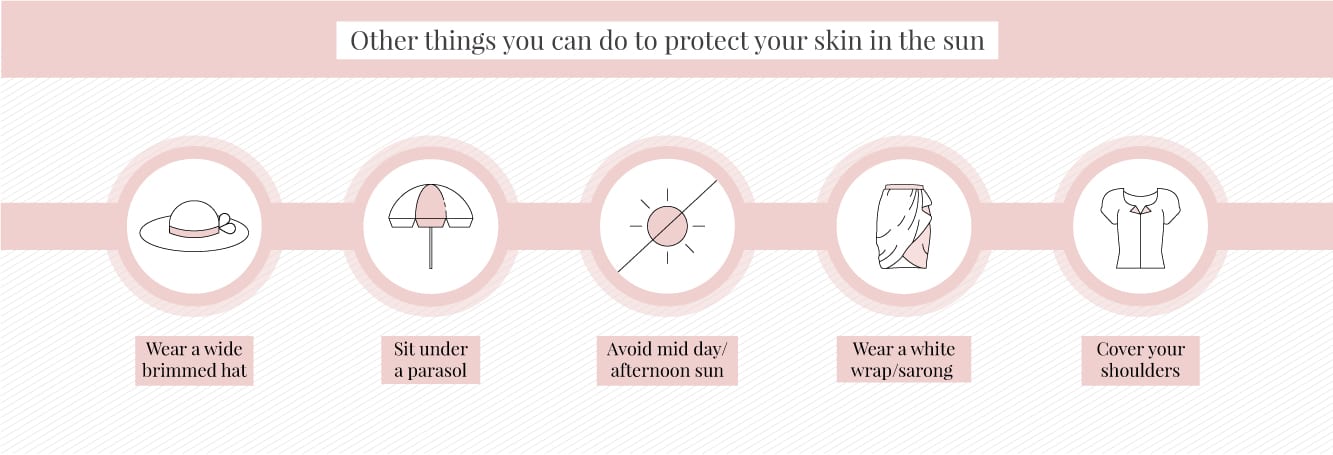
How does wearing SPF every day affect your course of laser hair removal treatment?
Wearing SPF every day increases the success rate of your treatment course. Applying this regularly to treatment areas if exposed minimises any changes in skin colour. However, it is important to note that if you are going on holiday and will be exposed to prolonged periods of sun exposure some skin types will still tan. The only way to avoid this is by staying in the shade and not exposing the skin in your treatment area.
How each skin type is affected by sun exposure
Pale skin tones
Skin types 1 to very pale 2 will see little or no change in the colour if their skin after sun exposure. These skin types will still have to use SPF 50 when away to avoid overexposure to sun resulting in sunburn. They also may have to wait 4-6 weeks depending on how much sun they have been exposed to while away and what condition their skin is in when they get back.
For example if a person with skin type 1 went to the sun for 2 weeks and had excessive periods of sun exposure that resulted in their skin becoming badly sun burnt they may have to wait longer for their skin to heal before having another session of laser hair removal.
Alternatively if another person with skin type 1 went to the sun for a week and avoided direct sun and applied SPF 50 every 2 hours and did not develop sunburn and their skin colour did not change they could resume session 2-3 weeks after they returned.
Medium skin tones
Skin types 3-4 will see a distinct change in skin colour if their skin has been exposed to sun. These skin types will have to be extremely careful not to over expose their skin to sun as doing so will result in a deep and long lasting tan developing. They may also have to wait a 6-8 week period and settings on the laser will have to be decreased considerably in order to avoid pigmentation occurring. Developing a deep tan could mean having to leave much longer gaps in between treatments also which will prolong the time frame of a course of treatment.
Dark skin tones
Skin types 5-6 will see very little change in skin colour after sun exposure. The laser used for these skin types works in a different way to pale and medium skin types. An Nd:Yag is used to treat these skin types safely. However these skin types still need to use SPF in the same way and also need to avoid prolonged periods of sun exposure. A wait time of 4-6 weeks is also required to allow the skin to rest after sun exposure.

Try to avoid any fluctuations in skin tone during a course of laser treatment

What are the risks to your skin if you don’t wear SPF every day during a course of laser?
There are risks to your skin if you expose your treatment area to sun and don’t wear SPF50. The 2 main complications that may occur are
1. Pigmentation can occur after laser hair removal treatment
This is one of the most common issues that can occur after sun exposure. Laser works by absorbing into dark pigment (melanin). Laser relies on the contrast between light skin and dark hair to work. At the start of a treatment course a safe setting is selected on the laser that corresponds to a persons specific skin and hair colour. After each treatment these settings are increased in order for treatment to continue to be effective. If skin is exposed to sun and the skin tone changes settings will need to be adjusted in line with the new skin tone. The same setting cannot be used as there is a high chance this setting will deliver too much heat into the skin and the stimulated melanin in the skin will react. If this happens the laser will target the pigment in the skin and pigmentation will occur.
Directly after the session the skin will appear red and feel very irritated. Over the next 10-14 days the area may appear darker and a crust will form. In the weeks following this the crust will flake off and areas of hypopigmentation will appear. These areas will return to normal over time but it can take a number of months. Topical products can help accelerate this process and help with the appearance of this. By protecting your skin from the sun you can avoid this happening in the first place.
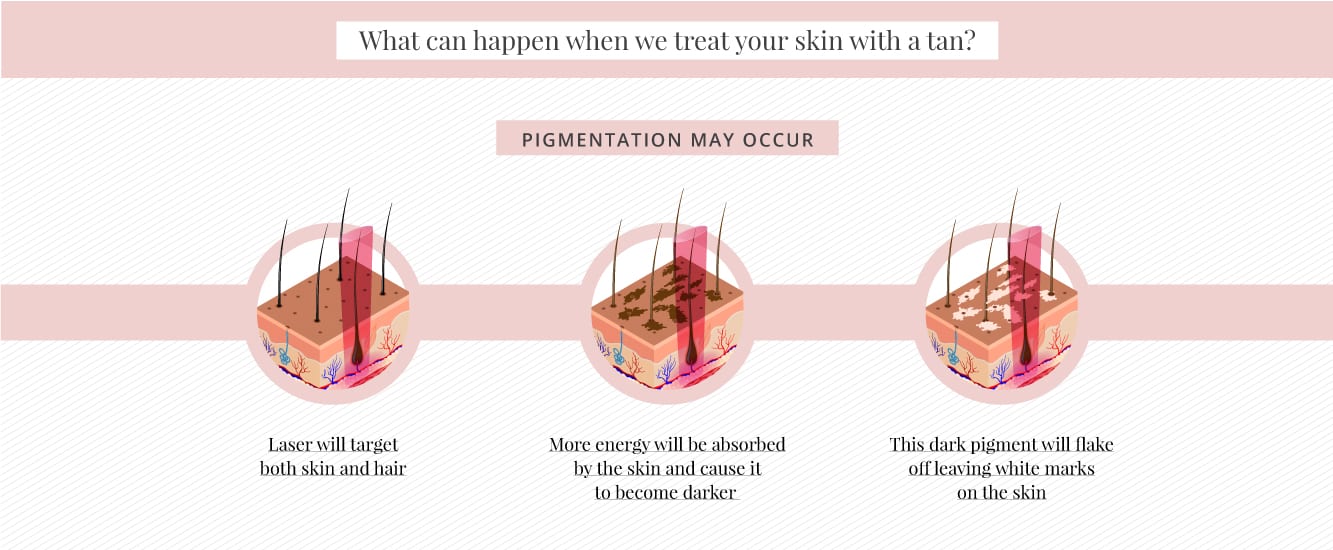
2. Skin irritation
After sun exposure it is quite common for the skin to become dry and dehydrated. Excess sun draws moisture from the skin and can make it dry and flaky. If skin has developed sun burn it will peel and the new skin underneath will remain very red and sensitive for some time after. Laser hair removal uses intense pulses of heat and dry, dehydrated skin won’t tolerate this well if it is compromised. Laser works best on skin that is healthy and hydrated. If laser is performed on excessively dry skin it can lead to the skin becoming itchy, inflamed and irritated for 5-7 days after treatment. This can feel quite uncomfortable especially at night time or when bathing or showering. It is essential that the skin is allowed time to replenish after sun exposure.
In the weeks after sun exposure light exfoliation and regular use of a moisturiser is recommended. This combination will to help restore the skin. A wait time of approximately 4-6 week after sun exposure will also help the skin rest and recover from these temporary drying effects of the sun.

The safety of your skin is the most important aspect of laser hair removal treatment. In no way should any unnecessary risks be taken while having treatment. These adverse affects can be completely avoided if periods of sun exposure are limited and the correct guidelines are followed. If you are undertaking a course of laser you must be willing to do all you can to protect your skin. Sun exposure may have to be limited for the duration of your course. If not your treatment course will be affected. Which may result in you needing more sessions over a longer period of time.
Do you have to wear SPF every day if your treatment areas are covered?
No, if your treatment areas are covered you do not need to apply SPF. Care and attention is needed though if you are out in the sun to make sure all areas remain covered. For example, if you are wearing ¾ length leggings apply sunscreen to the exposed skin on the ankle/feet area.
Another example is the back of the neck, this is often an area some people forget about when having laser. It is important to apply SPF50 to this area every 2 hours especially if working outdoors if having treatment on this area.
How many times a day do you need to reapply SPF to your treatment area?
You need to reapply SPF every 2-3 hours onto your treatment area if you are spending long periods of time in the sun. Once a day is not enough and will not provide the level of protection needed. If swimming on holiday or doing activities that cause you to sweat a good rule of thumb is to apply sunscreen directly after. Water and sweat will cause sunscreen to become less effective. In order to gain the maximum protection levels this will need to be applied regularly.
Protect your skin for a successful treatment outcome
To ensure you receive the best outcome from your laser hair removal treatments try to avoid sun exposure on your treatment area. Invest in a high performing SPF and apply it on a regular basis. Protecting your skin during your course will mean you will progress safely and will achieve the results you are looking for.
Start laser hair removal with us today
Contact us to arrange a free 30 minute laser consultation. Our friendly team of laser hair removal consultants will talk you through everything you need to know about laser.
